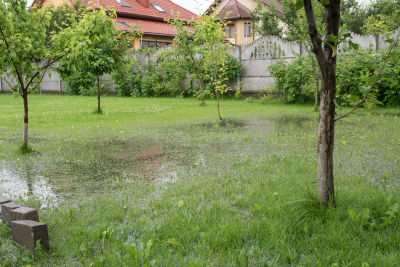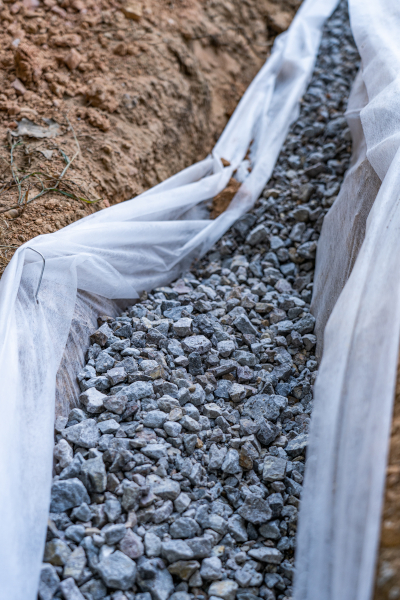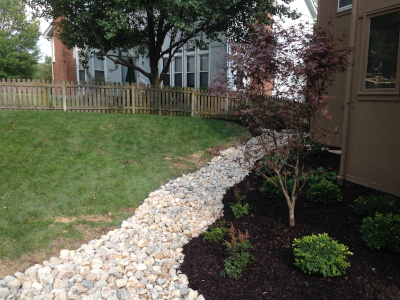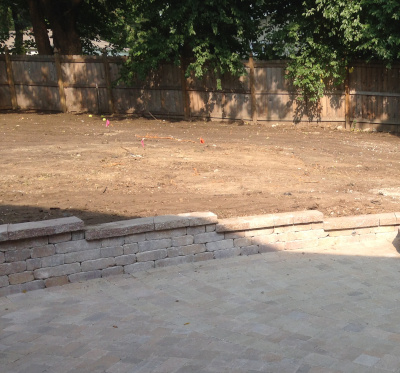
one
two
three



When planning your landscape, it is important to plan for stormwater management. Stormwater is the rain that does not sink into the ground. The wrong landscaping feature could direct stormwater right into your house. Or worse, in your neighbor's house. The basic principles of stormwater management are slow it down, spread it out, soak it in. There are several ways to accomplish this that preserve your landscaping without ruining anyone else’s.
Grading
The easiest way to direct stormwater is by using berms and swales. Swales are shallow valleys for the water to flow. In some cases, they slow down the water to drop contaminants and let the water slowly sink into the soil or evaporate. Berms are mounds that block the water from flowing a certain way and aim it toward the swales. Berms are often made from the dirt taken out of the swale since they work together. In landscape architecture, this is a strategy known as balancing the cut & fill on a site.
Rain Garden (Collection Boxes)
Rain gardens are cultivated areas in the swale that increase the ability of the swale to slow stormwater. They are planted with native and adapted plants that can handle being waterlogged, then dry. These gardens hold the water and let it soak in and recharge the groundwater. They also help filter out contaminants in the rainwater. In fact, rain gardens can soak in 30% more water than regular areas, filter out up to 90% of the nutrients, and up to 80% of sediments. Finally, they look nice.
Downspout Management
At one time, downspouts were used to direct water from the roof directly to storm sewers or hard surfaces like a driveway. These practices are now illegal in most places because they send nutrient-rich or contaminated water into storm sewers and straight into ponds or creeks. Now, downspouts are generally buried to send the water away from the foundation and back into the soil, where it is absorbed, or at least filtered before it runs off. The drain spout is disconnected, and a new underground pipe turns the output toward the direction the water should flow. You can use corrugated ADS or PVC pipe to send the water into the vegetation at least five feet from the foundation, or into a rain barrel or rain garden. This pipe can be buried so that the area looks nicer. Sump pumps can also be directed through this system, if the pipe is buried deeply enough the pipe doesn’t freeze. Sump pumps also need an emergency override, just to be safe.

French Drains
French drains are usually constructed to slow stormwater on a slope or collect groundwater in soggy areas. They consist of a trench filled with gravel. A pipe with holes in it accepts the water from the slope, then spreads it into the gravel, which helps the water flow where you direct it. There is a piece of filter fabric over the pipe to keep out sediment that would stop the drain from working as intended. A French drain should not be installed lower than the water table or it will not work well. Properly installed, a French drain will help keep swampy areas from forming in your yard. It is important not to run heavy equipment over the drain, so you do not crush the pipe or compact the soil.
Dry Wells
A dry well is a small pit lined with filter fabric cloth. It is then filled with gravel. When a storm comes, the well fills up with water. Over no more than 48 hours, all the water in the dry well will percolate into the soil. These dry wells work best with water that is relatively sediment-free, such as the water off the roof of buildings. Many times, downspouts are routed to a dry well. These should be built at least ten feet from the foundation and 75 feet from septic systems, water wells, surface water bodies.

Dry Creek Beds
These are areas where large amounts of water flow during storms. The gully or stream bed is lined with stones. Riparian plants usually line the sides of a dry creek bed. The stones prevent erosion while channeling water. They can also be constructed so they are a nice-looking part of the landscape even when dry.

Retaining Walls And Terracing
Retaining walls and terraces have been used for thousands of years to slow the flow of rainwater down a slope. The terrace is a flat area of soil held in by a retaining wall. The water can pond on the terrace, so it slows down. This makes the water more likely to sink in than to rush off the slope. Most terraces in home landscapes are landscaped into beds holding trees, shrubs, and perennials. The vegetation absorbs some of the ponded water and so helps keep it in the landscape, not running down the slopes.
In practice, most landscapes require more than one technique to manage stormwater. It is important to make sure all the stormwater management techniques work together, or they can make the ability to manage stormwater more difficult. As a practical matter, you usually need a landscape architect to design the management system and a general contractor to put the system in. Royal Creations Architectural Landscaping has both. Our Blue Crew will install your stormwater management system after our landscape architect develops the plan. Now is an excellent time to get your stormwater management system installed before the winter storms. Contact Royal Creations Architectural Landscaping today to address your stormwater management problems.